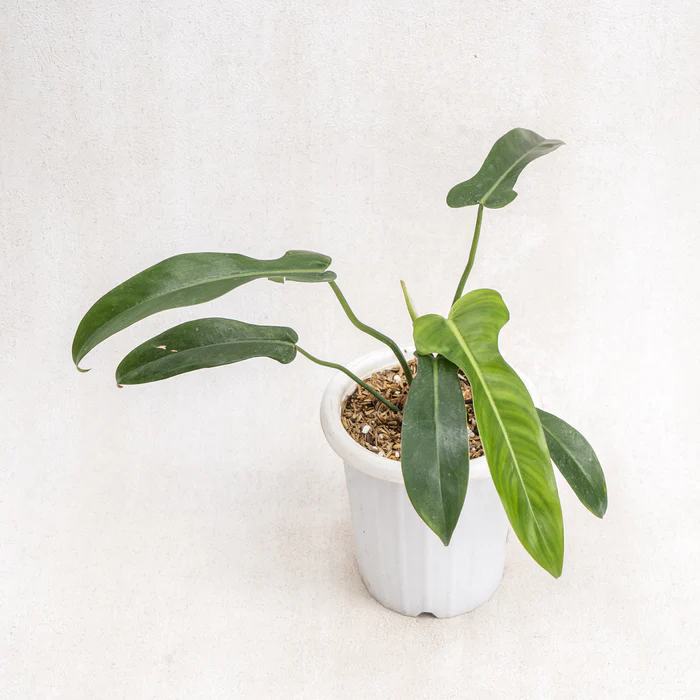Philodendron Jerry Horne- Rare
Original price was: ₹6,399.00.₹2,899.00Current price is: ₹2,899.00.
1 in stock
Selling size: Single plant | Pot Included | Free Shipping
Philodendron Jerry Horne: A Comprehensive Guide
1. Introduction to Philodendron Jerry Horne
Philodendron Jerry Horne is an increasingly popular houseplant known for its stunning foliage and easy-to-grow nature. This tropical beauty is a must-have for plant enthusiasts and interior designers alike. But what exactly makes it so special? In this guide, we’ll dive into the world of Philodendron Jerry Horne and explore its history, characteristics, care requirements, and more.
2. Origins and History
Philodendron Jerry Horne is a hybrid variety of the Philodendron genus, which originates from the tropical rainforests of Central and South America. The plant’s name is a tribute to the late Jerry Horne, an influential figure in the world of tropical plants and horticulture. As a hybrid, it combines the best traits of its parent plants, resulting in a plant that’s both visually stunning and easy to care for.
3. Characteristics
3.1. Appearance
The Philodendron Jerry Horne boasts large, heart-shaped leaves in a vibrant green hue, with a glossy finish that adds an element of elegance to any space. The leaves’ unique, wavy edges make it stand out from other Philodendron varieties.
3.2. Size and Growth Rate
When provided with the right conditions, the Philodendron Jerry Horne can grow fairly quickly. Mature plants can reach up to 3-5 feet in height and width, making it a perfect statement piece for your home or office.
3.3. Leaf and Stem Features
The plant’s leaves are supported by sturdy, reddish-brown stems that gracefully arch and cascade, adding to its overall visual appeal. The leaves’ size can vary, but they generally grow to be around 12-18 inches in length.
4. Care and Maintenance
4.1. Light Requirements
Philodendron Jerry Horne thrives in bright, indirect light. Direct sunlight can scorch the leaves, causing irreversible damage. If your space doesn’t have enough natural light, you can use a grow light to supplement its needs.
4.2. Watering Needs
Keep the soil consistently moist but not soggy. Overwatering can lead to root rot, so it’s essential to allow the top inch of soil to dry out between waterings.
4.3. Soil Preferences
A well-draining potting mix is essential for Philodendron Jerry Horne. You can use a mix of peat moss, perlite, and orchid bark to create the ideal growing medium for this plant. Ensure that the pot has drainage holes to prevent waterlogging.
4.4. Temperature and Humidity
As a tropical plant, Philodendron Jerry Horne enjoys warm temperatures and high humidity. Maintain a temperature range of 65-80°F (18-27°C) and avoid exposing the plant to drafts or sudden temperature changes. To maintain high humidity, you can mist the plant, use a humidifier, or place it on a pebble tray filled with water.
5. Propagation Techniques
Philodendron Jerry Horne can be easily propagated through stem cuttings. Select a healthy stem with at least one leaf and a node, and cut it below the node. Allow the cutting to air-dry for a few hours before placing it in water or moist potting mix. Keep the cutting in a warm and bright spot, and roots should develop within a few weeks.
6. Common Problems and Solutions
6.1. Pests and Diseases
Common pests that may infest Philodendron Jerry Horne include aphids, mealybugs, and spider mites. Wipe the leaves with a soapy water solution or use insecticidal soap to control these pests. To prevent fungal diseases, ensure adequate air circulation and avoid overwatering.
6.2. Yellowing Leaves
Yellowing leaves can indicate overwatering, underwatering, or a lack of nutrients. Check the soil moisture and adjust your watering schedule accordingly. If nutrient deficiency is the issue, apply a balanced, water-soluble fertilizer once a month during the growing season.
7. Benefits of Philodendron Jerry Horne
In addition to its aesthetic appeal, Philodendron Jerry Horne is also known to purify the air by removing harmful toxins like formaldehyde, benzene, and xylene. This makes it an excellent choice for creating a healthier indoor environment.
8. Conclusion
Philodendron Jerry Horne is an attractive and low-maintenance houseplant that can bring a touch of tropical elegance to any space. By providing the right care and conditions, this stunning plant can thrive and become a long-lasting addition to your indoor garden.
9. FAQs
Q1: Is Philodendron Jerry Horne toxic to pets?
A1: Yes, Philodendron Jerry Horne contains calcium oxalate crystals, which can be toxic to pets if ingested. Keep the plant out of reach of curious pets to avoid any issues.
Q2: How often should I repot my Philodendron Jerry Horne?
A2: Repot your Philodendron Jerry Horne every 2-3 years or when it outgrows its current pot. Choose a pot that is 2 inches larger in diameter than the current one and ensure it has proper drainage.
Q3: Can I prune my Philodendron Jerry Horne?
A3: Yes, pruning can help maintain the plant’s shape and encourage bushier growth. Use clean, sharp scissors to remove dead or damaged leaves and trim back overly long stems.
Q4: Why are the leaves on my Philodendron Jerry Horne curling?
A4: Curling leaves can be a sign of underwatering, low humidity, or a pest infestation. Check the soil moisture, adjust your watering schedule, and inspect the plant for pests.
Q5: Can Philodendron Jerry Horne grow outdoors?
A5: In regions with a suitable climate, Philodendron Jerry Horne can be grown outdoors. The ideal outdoor environment would have a consistently warm temperature and high humidity, similar to its natural tropical habitat. However, if you live in an area with cooler temperatures or harsh winter conditions, it’s best to keep the plant indoors or move it inside during the colder months.
Only logged in customers who have purchased this product may leave a review.















 If you need any assistance, I'm always here. Have you found what you were looking for?
If you need any assistance, I'm always here. Have you found what you were looking for?
Reviews
There are no reviews yet.